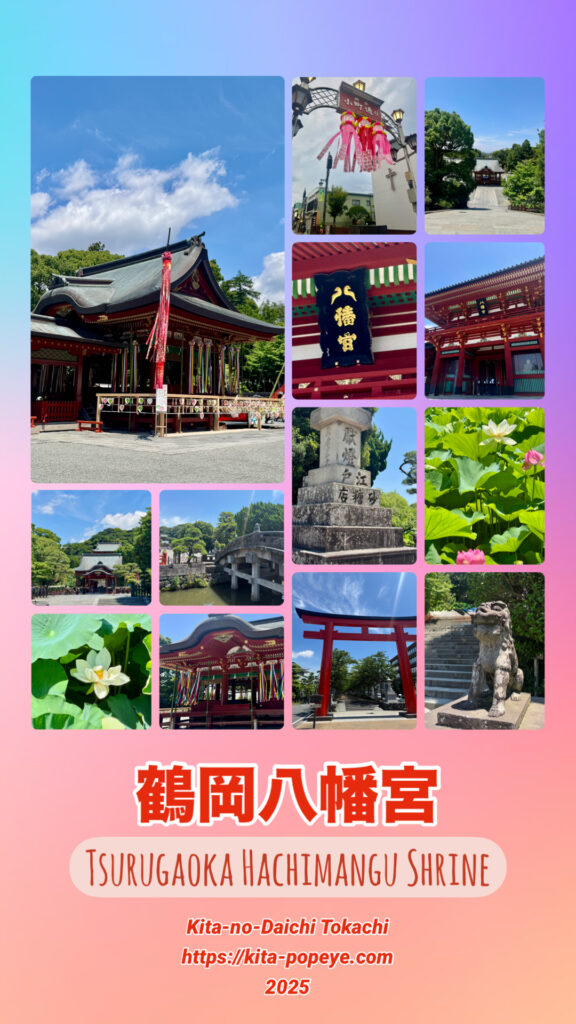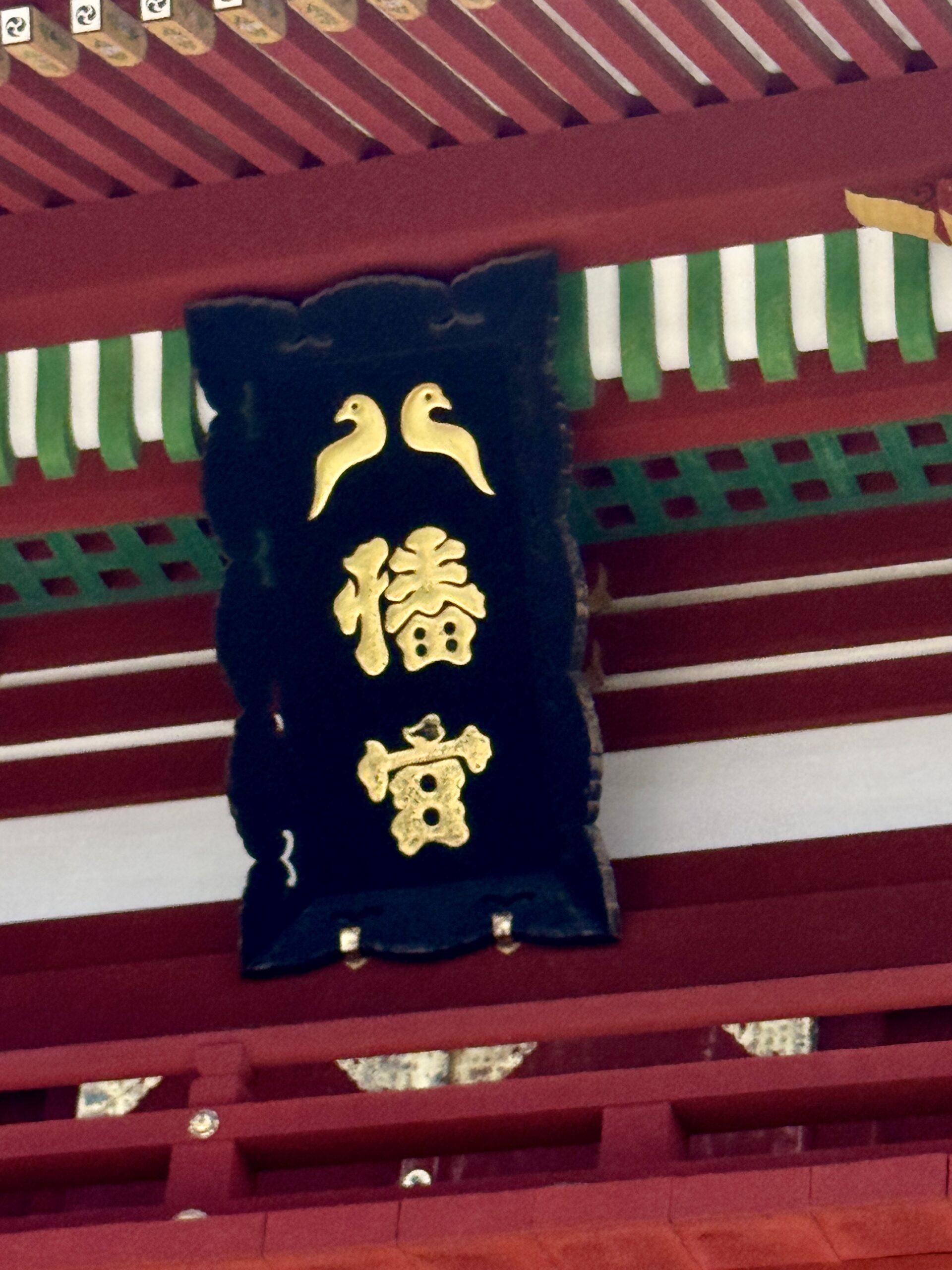#観光 #鶴岡八幡宮 #鎌倉観光 #
鶴岡八幡宮(TsuruokaHachimangu)
鶴岡八幡宮
鎌倉の象徴として知られる「鶴岡八幡宮」は、日本の歴史において非常に重要な役割を担ってきた神社です。その歴史、見どころ、ご利益について詳しくご説明します。
1. 歴史
* 創建: 鶴岡八幡宮の起源は、1063年(康平6年)に源頼義が奥州を平定した際に、源氏の氏神である京都の石清水八幡宮を由比ヶ浜辺に勧請したことに始まります。
* 鎌倉への遷宮: その後、源頼朝が1180年(治承4年)に鎌倉に武家政権(鎌倉幕府)を樹立する際、現在の場所に社殿を移しました。これにより、鶴岡八幡宮は鎌倉幕府の守護神となり、武士たちの精神的な拠り所となりました。
* 鎌倉のまちづくり: 鶴岡八幡宮は、単なる神社としてだけでなく、鎌倉の都市計画の中心としても機能しました。若宮大路(わかみやおおじ)という参道は、鶴岡八幡宮から由比ヶ浜までまっすぐ伸びており、鎌倉の街の骨格を形成しています。
2. ご祭神とご利益
* ご祭神: 以下の三柱の神様が祀られています。
* 応神天皇(おうじんてんのう):第15代天皇。
* 比売神(ひめがみ):宗像三女神。
* 神功皇后(じんぐうこうごう):第14代仲哀天皇の皇后。
これらの神々はまとめて「八幡神(はちまんしん)」と呼ばれ、古くから武運の神として信仰されてきました。
* ご利益:
* 勝運向上・出世開運: 武士の守り神であったことから、勝負事や仕事運にご利益があるとされています。
* 安産祈願・家内安全
* 交通安全・学業成就
など、多岐にわたるご利益があるとされています。
3. 主な見どころ
* 段葛(だんかずら): 鶴岡八幡宮の参道である若宮大路の中央にある、一段高くなった石畳の道です。桜並木が続き、季節ごとに美しい景色を楽しむことができます。
* 舞殿(まいどの): 大石段の手前にある社殿で、「下拝殿」とも呼ばれます。源義経の愛妾であった静御前が、義経を慕って舞を奉納した場所と伝えられています。現在も様々な神事や結婚式が執り行われています。
* 本宮(上宮): 大石段を登りきったところに建つ、八幡宮の中心となる社殿です。現在の建物は江戸時代の1828年(文政11年)に再建されたもので、国の重要文化財に指定されています。
* 源平池(げんぺいいけ): 境内にある二つの池で、太鼓橋を挟んで向かい合っています。源氏の繁栄を願って造られた「源氏池」には島が3つ(産)、平家の滅亡を願って造られたとされる「平家池」には島が4つ(死)あるという言い伝えがあります。
* 白旗神社(しらはたじんじゃ): 源頼朝公と源実朝公が祀られている神社です。黒塗りの社殿が特徴的で、勝負事や学業成就のご利益を求める人々が多く訪れます。
* 大銀杏(おおいちょう)の跡: 2010年に強風で倒伏してしまいましたが、その根から出たひこばえ(若芽)が育ち、新しい木として成長しています。
鶴岡八幡宮は、鎌倉の歴史と文化を感じる上で欠かせない場所であり、現在も多くの参拝者で賑わっています。

Tsurugaoka Hachimangu Shrine: A Symbol of Kamakura
Tsurugaoka Hachimangu Shrine is a major landmark in Kamakura, holding a deeply significant place in Japanese history. It served as the spiritual heart of the Kamakura Shogunate, the first samurai government in Japan.
1. History
* Origins: The shrine’s history dates back to 1063 when Minamoto no Yoriyoshi, a powerful samurai, established a branch of the Kyoto-based Iwashimizu Hachimangu Shrine near Yuigahama Beach after his victory in a northern campaign.
* Relocation to Kamakura: In 1180, Minamoto no Yoritomo, Yoriyoshi’s descendant, moved the shrine to its current location when he founded the Kamakura Shogunate. This made it the tutelary deity of the shogunate, and the focal point of the new samurai capital.
* City Planning: The shrine was more than just a religious site; it was central to the urban planning of Kamakura. The main approach to the shrine, Wakamiya Oji Street, was built as a straight path from the shrine to the sea, forming the city’s main axis.
2. Deities and Blessings
* Main Deities: The shrine worships three main deities, collectively known as Hachiman-jin, who are considered the god of war and warriors:
* Emperor Ōjin (the 15th Emperor of Japan)
* Himegami (a group of three goddesses)
* Empress Jingū (the wife of the 14th Emperor)
* Blessings (Gori-eki):
* Victory and Success in Business: Due to its history as a patron of samurai, the shrine is believed to bring good fortune in business and competitions.
* Safe Childbirth and Family Safety
* Traffic Safety and Academic Success
3. Key Features
* Dankazura: This elevated path running through the center of Wakamiya Oji Street is the main approach to the shrine. It is lined with cherry trees and is a popular spot for viewing blossoms in the spring.
* Maidono (Lower Sanctuary): Located at the base of the main stone steps, this is a stage for rituals and ceremonies. It is famously where Shizuka Gozen, the lover of Minamoto no Yoshitsune, performed a dance expressing her longing for him.
* Hongu (Main Hall): At the top of the grand staircase, this is the main sanctuary of the shrine. The current structure was rebuilt in 1828 and is a designated Important Cultural Property of Japan.
* Genpei Ponds: The two ponds in the shrine grounds are separated by a drum bridge. The Genji Pond (named after the Minamoto clan) has three islands, representing prosperity, while the Heike Pond (named after the Taira clan) has four islands, a number associated with death in Japanese culture.
* Shirata Hachimangu Shrine: This smaller shrine within the grounds is dedicated to Minamoto no Yoritomo and his son Sanetomo. Its striking black-lacquered exterior makes it a notable feature, and it is a popular spot for those seeking good luck in academic pursuits and victory in general.
* Great Ginkgo Tree: The massive ginkgo tree, which stood for over 1,000 years, toppled in 2010. However, new sprouts (known as hikobae) have emerged from its roots, symbolizing resilience and rebirth.
Tsurugaoka Hachimangu is a vital place to experience the rich history and culture of Kamakura, and it continues to attract countless visitors today.
Tsuruoka Hachimangu


YouTube
Note

北海道
北の大地十勝(北海道)に移住
tokachi_sky (とかちスカイ)北の大地十勝 Kita-no-Daichi Tokachi






コメント